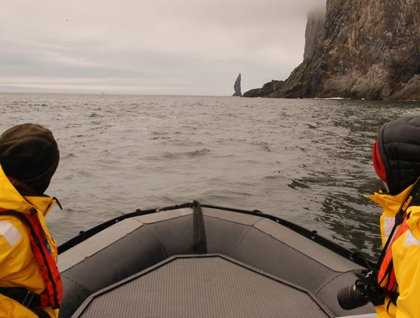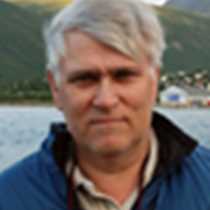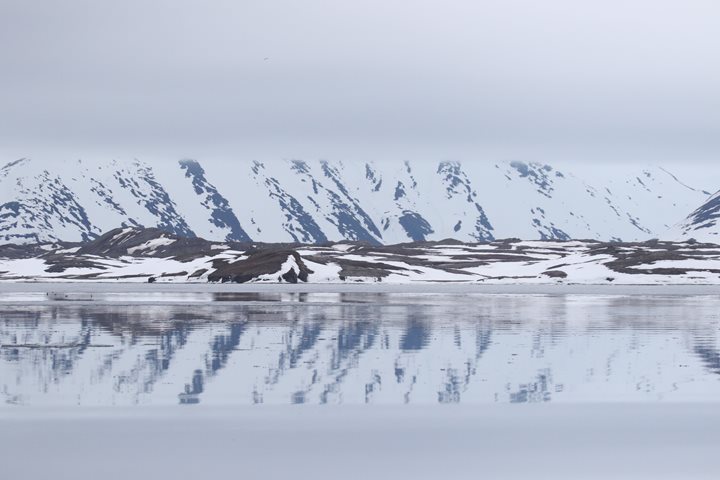We have now departed from the Scandinavian Peninsula and are heading north to the area usually called the High Arctic. The Arctic is harder to define than Antarctica. Some use the Arctic Circle but here in northern Scandinavia this would be a very poor way, as the warm water North Atlantic drift (Gulf Stream) gives us the ability to live and even grow potatoes and strawberries at the latitude of Tromsø, which is almost the same as Point Barrow in northern Alaska.
The High Arctic is the region governed by 24-hour darkness through the winter, snow and ice, but during a short summer with is 24-hour daylight “explodes” with life. The ocean, at least in winter, is covered by heavy and thick sea ice and in some areas way into summer. Now we are steaming north along the western edge of the shallow Barents Sea, more or less on the shelf drop off. Barents Sea, together with the Bering Sea, are the two most productive bodies in the ocean in the world, because of the 24 hour daylight (input of energy), the cold water (maintain oxygen), and they are both very shallow. Along the ship during the morning we saw plenty of true pelagic seabirds, like fulmars and kittiwakes, and the most persistent bird watchers even recorded both pomarine and long-tailed jaegers (skuas).
The Barents Sea was first sailed by the Vikings, but among the Europeans it was the English and Dutch who tried to find a shortcut to Cathy (China) around 1553-1697 to compete with Portugal and Spain on their extremely profitable trade with spices and different commodities, and they started to explore and map the region. Instead of sailing around Africa they thought they would be able to find a shortcut but soon realized they had to deal with a completely different environment, the cold and sea ice.
Willem Barents was sent out in 1596, from a Dutch trade company, with the mission to sail over the Pole and reach Cathy. In early June 1596 he spotted an island and they went ashore and soon encountered a white large bear, which was killed. They named island to ‘Beeren Eiland’ and today known as Bjørnøya (Bear Island). Of course the sea we are sailing in is named after this famous Dutch navigator who later died at Novaya Zemlaya in spring 1597 after his ship had been crushed and they were forced to winter in a very desolate spot. Some of his crew later made it back to Holland to tell the story. A few years after the Dutch, an English expedition re-found the same island and named it after their supporter, Lord Cherry, but this did not last.
Right after lunch we approached this remarkable island, located where the warm water originating off the Yucatan off Mexico, meets a cold-water current from eastern Siberia. And if warm water meets cold, or vice versa, anyone from San Francisco knows there is fog. In the summertime only 3-4 clear days are recorded on the average at Bjørnøya. We anchored the ship in the only sheltered bay, Sørhamna, partly embedded in a mystical fog and soon the whole Zodiac fleet was ready for a long exiting and remarkable adventure.
Along the southern side of the island limestone cliffs rise to about 300-400 meters, covered with breeding seabirds: common and thick-billed murres, kittiwakes, and fulmars. Add also mystical tunnels, caves and strong currents, tides, swell, and waves from several directions. Those who reached as far as the very southwest corner of the island also saw the figurehead, “The Needle,” standing on its own looking out over the ocean like the stone heads at Easter Island. You have one on the most magical Zodiac cruises you can do in the world.
The birds are hard to count but the cliff faces are literally covered with them. Being the only major island sitting in the middle of one of the most productive seas in the world, several 100,000s seabirds gather here for their breeding. For the kittiwake and the murres it is the small fish capelin, which is the base food.
During our Recap we steamed along the western side of the island and slowly left the fog behind, and our Philippine dinner made by our excellent crew was the third highlight of a day filled with knowledge and adventures. Tomorrow we go into the ice for a real polar treat and more exploration.







